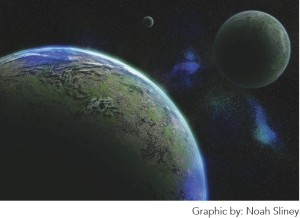There are more planets than we know.
By: Caroline Frank
Staff Writer
On Feb. 22, 2017, NASA released an article called, “NASA Telescope Reveals Largest Batch of Earth-Size, Habitable-Zone Planets Around Single Star.” The article consisted of the recent discovery of seven planets that revolve around a star and could potentially have life-sustaining properties. The solar system, named Trappist-1, may be habitable under a certain set of circumstances.
Trappist is a Belgian-operated telescope in Chile that found two planets in 2016 and inspired the name. In 2017, NASA’s ground-based telescopes, along with their Spitzer space telescope, found five more.
“I would have never predicted this,” Project Scientist Nikole Lewis said.
Lewis is an astronomer and co-leader of the Hubble study at the Space Telescope Science Institute in Baltimore, Maryland.
She said if you were standing on one of these planets, you would actually see a lot of them in the sky whipping by on very short orbital periods.
“It’s beyond anything I could have ever dreamt of,” Lewis said.
NASA plans to release a telescope called the James Webb Telescope by 2018 that will be able to detect traces of methane, oxygen, and other gases crucial to a livable atmosphere, according to the article on NASA’s website.
Three of the seven planets in Trappist-1 are already in the habitable zone around the star. However, the James Webb Telescope will be able to examine the planets more closely and determine whether there are more atmospheres suitable to hosting life, according to the same article.
“The James Webb Space Telescope will have the possibility to detect the signature of ozone if this molecule is present in the atmosphere of one of these planets,” Physical Science Instructor at Meramec Joe Schneider wrote in an e-mail. “This could be an indicator for biological activity on the planet.”
Webb said this discovery was rare because these planets have the combination of being similar in size to Earth and having a temperature that could have water on their surfaces and potentially support life.
“This is the first time that so many planets of this kind have been found around the same star. [It was an] amazing discovery!” Schneider wrote.
Schneider wrote that he thinks these planets have the ability to sustain life.
“Earth-like exoplanets orbiting dwarf stars are easier to observe than earth-like planets around solar-type [larger] stars,” Schneider wrote. “Since these dwarfs [sic] are also much cooler, the temperature zone that allows water to be liquid on the surface of the planet is much closer to the star. When viewing the star, the chance is much better you will also see the close planets. I know there are nearly 600 targets that will be observed in the future.”
Meramec graduate Roland Barge said he was beyond excited.
“If this discovery ends up leading to [a] planet, or [a] series of planet life, I believe this announcement will be the most monumental in modern history,” Barge said. “Sure, Elon Musk is working on terraforming Mars and opens the possibility of humans expanding within our solar system, but this could open the door to humans living outside of the solar system.”
Roland said he hopes humans expand to other planets, solar systems and galaxies.
“Considering how we have destroyed our planet in almost every turn, I hope humans learn from the mistakes we have made on Earth during these explorations to new uncharted territories,” Barge said.











